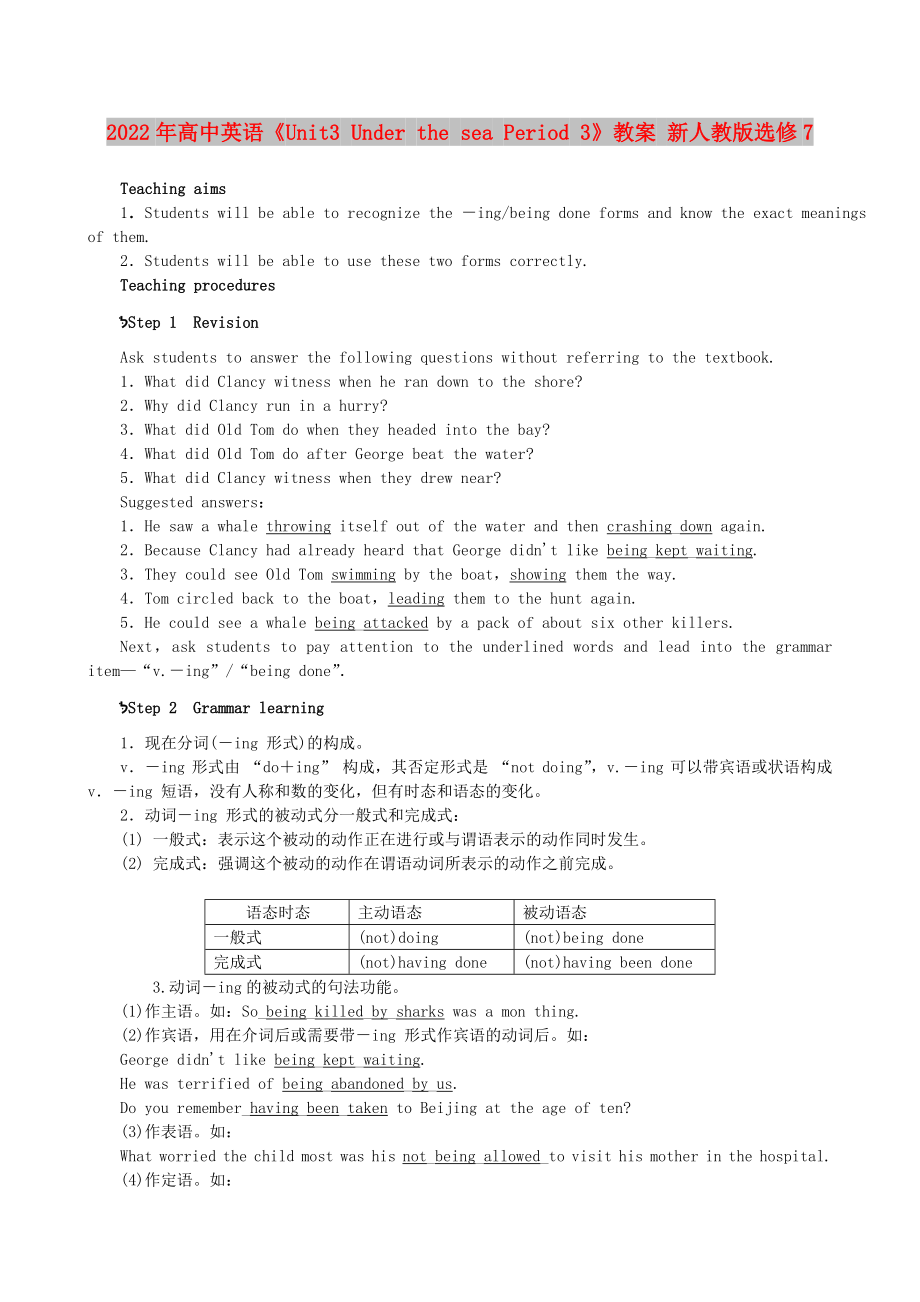《2022年高中英語《Unit3 Under the sea Period 3》教案 新人教版選修7》由會(huì)員分享��,可在線閱讀��,更多相關(guān)《2022年高中英語《Unit3 Under the sea Period 3》教案 新人教版選修7(3頁珍藏版)》請?jiān)谘b配圖網(wǎng)上搜索��。
1��、2022年高中英語《Unit3 Under the sea Period 3》教案 新人教版選修7
Teaching aims
1.Students will be able to recognize the -ing/being done forms and know the exact meanings of them.
2.Students will be able to use these two forms correctly.
Teaching procedures
Step 1 Revision
Ask students to answer t
2��、he following questions without referring to the textbook.
1.What did Clancy witness when he ran down to the shore?
2.Why did Clancy run in a hurry?
3.What did Old Tom do when they headed into the bay?
4.What did Old Tom do after George beat the water?
5.What did Clancy witness when they drew ne
3��、ar?
Suggested answers:
1.He saw a whale throwing itself out of the water and then crashing_down again.
2.Because Clancy had already heard that George didn't like being_kept_waiting.
3.They could see Old Tom swimming by the boat��,showing them the way.
4.Tom circled back to the boat��,leading them t
4��、o the hunt again.
5.He could see a whale being_attacked by a pack of about six other killers.
Next��,ask students to pay attention to the underlined words and lead into the grammar item—“v.-ing”/“being done”.
Step 2 Grammar learning
1.現(xiàn)在分詞(-ing 形式)的構(gòu)成��。
v.-ing 形式由 “do+ing” 構(gòu)成��,其否定形式是 “not doing”��,v
5��、.-ing 可以帶賓語或狀語構(gòu)成 v.-ing 短語��,沒有人稱和數(shù)的變化��,但有時(shí)態(tài)和語態(tài)的變化��。
2.動(dòng)詞-ing 形式的被動(dòng)式分一般式和完成式:
(1) 一般式:表示這個(gè)被動(dòng)的動(dòng)作正在進(jìn)行或與謂語表示的動(dòng)作同時(shí)發(fā)生��。
(2) 完成式:強(qiáng)調(diào)這個(gè)被動(dòng)的動(dòng)作在謂語動(dòng)詞所表示的動(dòng)作之前完成��。
語態(tài)時(shí)態(tài)
主動(dòng)語態(tài)
被動(dòng)語態(tài)
一般式
(not)doing
(not)being done
完成式
(not)having done
(not)having been done
3.動(dòng)詞-ing的被動(dòng)式的句法功能��。
(1)作主語��。如:So_being_killed_by_
6��、sharks was a mon thing.
(2)作賓語��,用在介詞后或需要帶-ing 形式作賓語的動(dòng)詞后��。如:
George didn't like being_kept_waiting.
He was terrified of being_abandoned_by_us.
Do you remember_having_been_taken to Beijing at the age of ten?
(3)作表語��。如:
What worried the child most was his not_being_allowed_to visit his mother in the
7��、 hospital.
(4)作定語��。如:
The problem being_discussed is of great importance.
(5)作狀語。如:
Having_been_shown_around the library��,we were taken to see the lab.
(6)作補(bǔ)足語��。如:
As we drew closer��,I could see a whale being_attacked by a pack of about six other killers.
When we approached him��,I saw James being_
8��、held_up in the water by Old Tom.
[注意]
(1)v.-ing 形式的被動(dòng)式主要在句子中作狀語��、賓語補(bǔ)足語和定語��。但v.-ing 形式的被動(dòng)式的完成式��,一般在句中作狀語(偶爾作非限定定語)��,不作其他成分��。
They don't like the_design_of_the_new_bridge_being_built.(正在建造的橋的設(shè)計(jì))
Not_having_been_pleted��,the museum can't be visited yet.(由于沒有完工……)
(2)v.-ing 形式的被動(dòng)式邏輯主語(即動(dòng)作的承受者)如果也是主句的主語��,就不
9、需要表示出來��,但是如果邏輯主語不是主句的主語��,就得把v.-ing 形式自己的主語表示出來��。如:
The whole classroom having_been_cleaned��,the students went home happily.
(3)在want��,need��,deserve��,require��,repay��,bear��,take等動(dòng)詞及形容詞worth后��,習(xí)慣用動(dòng)詞-ing的主動(dòng)形式表示被動(dòng)意義��,相當(dāng)于“to be done”��。如:
The house wants_cleaning. 這房屋需要打掃��。
My watch needs_repairing. 我的手表需要修理��。
10��、
The way deserves_mentioning. 這個(gè)方法值得一提��。
These young trees will require_looking_after carefully.
這些小樹需要細(xì)心照顧��。
The film is worth_seeing. 這部影片值得一看��。
Step 3 Exercises
句型轉(zhuǎn)換(改成帶-ing形式被動(dòng)結(jié)構(gòu)的簡單句)
(1)The hotel which is being built now beside the park was designed by a group of young men.
(2)The li
11��、ttle girl was eventually aware that her parents abandoned her in the mountainous village.
(3)He would e even if we don't invite him.(without)
(4)After he had been examined several times��,he was told to be healthy.
(5)I noticed that some people were taken to the police station.
Suggested answers:
12��、
(1)The hotel being built now beside the park was designed by a group of young men.
(2)The little girl was eventually aware of being abandoned by her parents in the mountainous village.
(3)He would e without even being invited.
(4)After having been examined several times��,he was told to be healthy
13��、.
(5)I noticed some people being taken to the police station.
Step 4 Drilling
Ask students to do Exercise 1 on Page 23 and check with their partners then check together.
Ask students to do Exercise 2 and check the answers together.
Keys:1.being attacked 2.Being held up 3.Being included 4.Havin
14��、g been accepted
5.being told 6.Being helped out 7.being taken 8.being photographed 9.being swallowed.
Step 5 Using structures
Show students the 6 pictures on Page 64 and ask them to describe them using the passive -ing form in pairs.
Keys:1.being invited 2.being kept waiting 3.being attacked 4.being awarded 5.being shouted at 6.being blamed
Step 6 Homework
Finish off Exercise 2 on Page 64
 2022年高中英語《Unit3 Under the sea Period 3》教案 新人教版選修7
2022年高中英語《Unit3 Under the sea Period 3》教案 新人教版選修7

